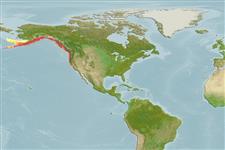Common names from other countries
>
Gadiformes (Cods) >
Gadidae (Cods and haddocks)
Etymology: Microgadus: Greek, mikros = samll + Latin, gadus = a fish, cod? (Ref. 45335); proximus: From the Latin 'proximus' meaning next (Ref. 6885).
More on author: Girard.
Environment: milieu / climate zone / depth range / distribution range
Ecologie
marien; brak water demersaal; oceanodroom (Ref. 51243); diepte 0 - 275 m (Ref. 1371), usually 25 - 120 m (Ref. 1371). Temperate; 62°N - 36°N, 179°W - 121°W (Ref. 1371)
Eastern Pacific: southeastern Bering Sea to central California, USA.
Grootte / Gewicht / Leeftijd
Maturity: Lm ? range ? - ? cm
Max length : 30.5 cm SL mannelijk / geslacht onbekend; (Ref. 27436)
Dorsale stekels (totaal): 0; Dorsale zachte stralen (totaal): 46-54; Anale stekels 0; Anale zachte stralen: 38 - 46. Body olive green dorsally, pale ventrally; fins dusky marginally.
Generally found over sand (Ref. 1371). May enter brackish water (Ref. 1371). Young move into shallow waters in summer and fall, whereas adults usually stay in deeper waters (Ref. 28499). Feeds on shrimps, amphipods, isopods, gastropods, mussels and fishes (Ref. 1371). An important prey species (Ref. 2850).
Oviparous, sexes are separate (Ref. 205).
Cohen, D.M., T. Inada, T. Iwamoto and N. Scialabba, 1990. FAO species catalogue. Vol. 10. Gadiform fishes of the world (Order Gadiformes). An annotated and illustrated catalogue of cods, hakes, grenadiers and other gadiform fishes known to date. FAO Fish. Synop. 125(10). Rome: FAO. 442 p. (Ref. 1371)
Status op de Rode Lijst van het IUCN (Ref. 130435)
CITES (Ref. 128078)
Not Evaluated
Gevaar voor de mens
Harmless
Gebruik door de mens
Visserij: van minder commercieel belang; sportvis: ja
Tools
Speciale rapporten
Download XML
Internetbronnen
Estimates based on models
Preferred temperature (Ref.
115969): 3.4 - 9.5, mean 5.8 (based on 253 cells).
Fylogenetische diversiteitsindex (Ref.
82804): PD
50 = 0.7500 [Uniqueness, from 0.5 = low to 2.0 = high].
Bayesian length-weight: a=0.00794 (0.00418 - 0.01508), b=3.10 (2.94 - 3.26), in cm Total Length, based on LWR estimates for this (Sub)family-body shape (Ref.
93245).
Trofisch niveau (Ref.
69278): 3.6 ±0.59 se; based on food items.
Weerstandsvermogen (Ref.
120179): Gemiddeld, minimale populatieverdubbelingstijd 1,4-4,4 jaar (tm=2).
Fishing Vulnerability (Ref.
59153): Low to moderate vulnerability (27 of 100).
Climate Vulnerability (Ref.
125649): Moderate to high vulnerability (51 of 100).
